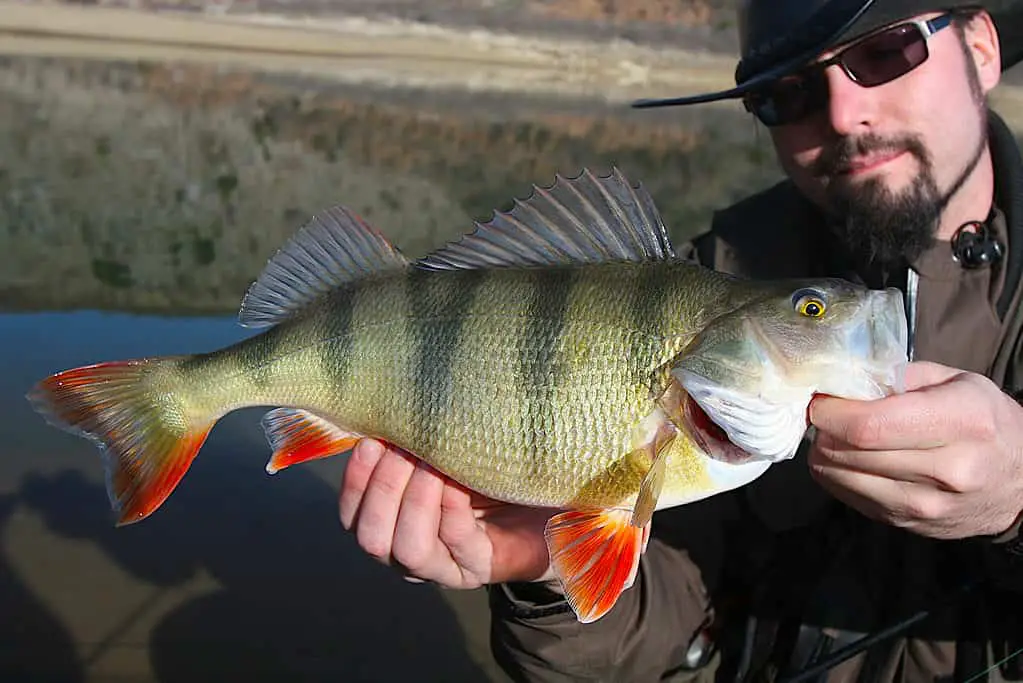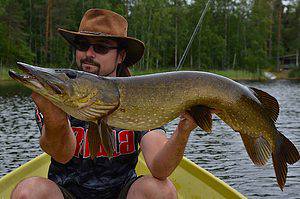Disclosure: Some posts contain affiliate links, which earn us a commission if you make a purchase through them. Positive Fishing © participates in various affiliate networks including the Amazon Services LLC Associates Program.
There is a long-standing debate among predator fishing anglers from all over the world. Are live baits better than dead baits?
There is no simple answer to this question. Fishing is a sport that includes an insane array of factors that can and will affect the result of our efforts. Both dead and live baits have their moments, and arguing that one is better than the other is nothing more than an endless debate!
There is only one way of finding the answer to this question. Go and try both options! Both work but not every time.
In the following article, I will cover the following:
- Live baits and dead baits are both very effective for predator fishing
- What are the important aspects of both live and dead baits
- When to use which one or the other
When Is Live Bait The Best Option?
- Provides better presentation
- It’s, of course, more lifelike
- It has a natural movement in the water
- It flashes and is easier for target fish to see
- Generally, they catch more fish
- They are better in both clear and dark colour water
When is Dead Bait The Best Option?
- If live baits are banned – some fisheries often ban live bait fishing
- When you are unable to catch any live bait
- If the target fish are not interested in live baits
- They do not need storage
- Their smell is stronger
Our Choice – Live Bait! (Marginally)

when using a bleak as live bait
Tip: Some fisheries only allow predator fishing during the winter months. Always check the rules where you plan to fish.
The general opinion will always lean towards live bait fishing. The reason is quite simple: there is no better food offering for a predator than its natural prey if presented correctly! Live bait fishing can be so successful, especially when pike fishing. It’s so productive that many fisheries today have a strict no-live bait fishing policy!
But the road to success is often not easy as it might seem at first glance. To achieve a string of success, there are great tips and guidelines that you need to consider and apply!
Where to Use Live Bait?
Live bait is a universal choice for all kinds of waters and predator fish species. Pike are the most common fish targeted with live bait, but there are also zander, perch, and catfish. If you are fishing with small baitfish, there is also a good chance of catching a decent chub!
When fishing with live bait, you need to know your limitations. And the biggest one is the size of the terrain you can cover! When compared to lure fishing, live bait fishing covers less than 1% of the water you would cover with lures. Why? Well, simply because you cannot cast and retrieve your live bait so often. The live offering has limited use and would die in no time!
This also means you cannot cast infinitely, as most fish species used as bait will not survive such treatment. Once you make your cast, you should keep the bait in the water as long as possible if the bait is still alive.
So, choosing a perfect spot is essential. Depending on the fish you are after, try reading the water as well as you can and present your bait at the spot that is most likely to hold a predator. For pike, this could be a sunken tree; perch, a patch of underwater grass; zander, an underwater structure; and catfish, a deep hole in the river bed.
How to Use Live Bait?
The most common technique of live bait fishing is using a simple float rig. It has a lot of variation, but it is probably the best option for most situations, as it will keep your baitfish from finding cover on the bottom.
At the same time, bite indication on the float is very straightforward, and you can clearly recognize the pattern of attacking and swallowing the bait, which is very important for pike fishing!
It is also important to hook the fish properly. When hooking the bait, avoid damaging the vital parts of the fish so it stays alive! The hook should be placed either at the tail area, through the back, or at a fish’s mouth. I use only one hook through the back of the fish, just under the dorsal fin, as this will allow the fish much movement without inflicting serious damage.
When casting, you need to be careful. Full-strength casts will kill your bait instantly! Try doing it as gently as possible, and try to avoid fishing at long distances. Fishing near the bank or the margins for predator fish often brings the best results!
What is the Best Choice for Live Bait?
This is a very controversial question, as almost every angler out there has a live bait preference that he will swear his life on. One will say nothing beats a live chub, while another will bet on fishing with a live roach.
However, three important tips will help you choose the right live bait.
1. The most important rule of live bait fishing is – never to use a live fish from another water.
Introducing other fish species in the water body, especially open water, is illegal in many locations. Many waters have been seriously compromised due to the invasion of crucian carp, which have mistakenly been released into the water because of anglers’ live bait escaping or coming off the hook.
There is also a risk of KHV disease (Koi Herpes Virus) spreading between lakes.
2. Adjust your bait to the expected fish species. If you are fishing for perch, a small bleak or roach measuring 5-10 cm is a great choice. For zander, a 10 cm bleak is a perfect solution. But size is everything for a pike, especially if you are after a big one! Larger bait will bring bigger fish; a 200 g roach is just about right for targeting the bigger pike. Otherwise, you will spend your time on too many smaller pike.
3. Predator fish species prefer shiny fish, such as chub, roach, rudd, skimmer or bleak. These fish will make a lot of flashes in the water while trying to escape the hook, and a combination of shine and vibration is a perfect trigger for getting a strike. A fish like a perch is to be used only if no other option is available!

Dead Bait Fishing
Why would you choose dead bait rather than live bait? Well, there are a couple of obvious reasons.
First, having dead bait available is a great alternative if you cannot catch live bait where you plan to fish. Also, when planning your fishing trip, carrying live bait around with you demands a lot of additional effort. You will need a water container, an aerator, and more space in your vehicle. When using dead bait, you need a bag!
Second, dead bait has one great advantage over live bait. And that is the scent!
Live bait will shine and vibrate through the water to attract predators. Dead bait will lie on the bottom, but if prepared correctly, it will release many scents predators find irresistible. This is especially good when fishing for catfish or zander – they love eating dead fish and cut baits!
Where to Use Dead Bait?
Dead bait fishing implies the same rules as live bait fishing. The closer to the potential predator fish habitat, the better! But as we have just mentioned, an additional scent component is present that gives you a decent edge in finding a fish.
Dead baits are especially efficient when fishing in moving water. The scent will travel downstream faster than you would think, and if predators are nearby, they will be attracted to your bait in no time! Both catfish and zander will eagerly search and eat your dead bait if the spot is good enough.
This also means dead bait fishing is best when these fish are active at night. If you are after catfish, try finding a rock-covered stretch on your river to try your luck with zanders or a deep hole on the river bend.
When fishing for pike, there is no need to complicate things. Cast your bait to any promising spot, and give it some time. Pike has a keen sense of smell, and your bait will not go unnoticed for very long! Dead bait fishing for pike is most efficient during the winter months.
How to Use Dead Bait?
If you take a dead fish, hook it, and toss it in the water, you might end up disappointed with the results.
When fishing with dead bait, it is quite important to prepare it correctly. The scent is your main weapon, so make sure you use it well!
You can do this by filleting a fish or by cutting bait. If you are using a whole fish, take a knife and peel off the skin from one side of the body – it will release a lot more scent! You can also try squashing the fish with your foot. Do not overdo it; press it hard enough to tear the flesh.
Tip: Before you hit the water, you need to check out the rules of your fishery – both live and dead bait fishing are forbidden on many waters. Always comply with the rules!
What is the Best Choice for Dead Bait?
It is completely the same as with live baits – but with one important difference!
Dead bait fishing offers you an opportunity to use saltwater fish in freshwater. Mackerel, for example, is one of the most famous big pike bait in the UK, and there are numerous tips and tricks regarding this fishing technique. Smaller fish, such as sprats, can also be very productive!
Also, you can use squid for catfish. It sounds crazy, but squid is one of the best catfish baits out there. It smells awful, can endure long casts without a problem, and nothing will eat it except catfish!
How To Use Treble Hooks For Live And Dead Bait?
Treble hooks are an excellent choice for using when fishing live and dead baits. Since a treble hook is three individual hooks on the same shank, it can improve your strike rate.
Pike and other predatory fish have tougher mouths, making them harder to penetrate. Pike attacks the bait from various directions, so the three-pronged hooks have a greater opportunity to latch into the fish’s mouth.
However, in many locations, treble hooks are banned. Always check your local rules before using. If treble hooks cannot be used, use a standard inline hook instead. These can be paired up on a leader if using a large bait.
Where Are The Best Places To Buy Dead Baits?
Supermarkets and grocery stores have the largest number of options and the most economical places to get dead bait for any form of predator fishing. You can also find some bargains on fish which are nearing their sell-buy date.
Final Thoughts
Both live and dead baits have their moments and will bring success if done right. Live bait fishing requires more work, while dead bait tends to be a bit dirtier: but these are all joys of fishing!
It is up to you to try them both, then decide which one gets you the best results!
Learn more about the basics of freshwater predator fish, including their habitat and their unique traits.
- Winter Lure Fishing For Catching Zander In Rivers & Lakes - January 22, 2022
- What Is Bolognese Fishing? The Ultimate Guide To Bolo Fishing - December 29, 2021
- How To Catch Carp: The Best Carp Hookbaits Revealed - November 17, 2021

